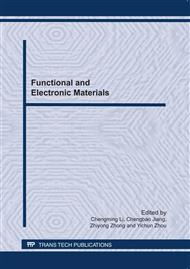p.65
p.70
p.75
p.80
p.85
p.90
p.99
p.106
p.112
Growing Behaviors of Oxidation Film on the Surface of Liquid Sn-0.68Cu-0.3Ag-X Solder
Abstract:
A lead-free hypoeutectic solder Sn-0.3Ag-0.68Cu-X with low sliver content was prepared by a new process. By the method of skimming surface oxidation film at static state, the growing behaviors of oxidation film on the surface of liquid solder alloy were studied. The experimental results show that the growth rate of oxidation film on the surface of liquid solder decreases greatly after surface modification process. Before the surface modification process, the growth behaviors of oxidation film on the surface of liquid solder obey parabolic law which changes with variation of time. After surface modification, the growth behavior of oxidation film of liquid solder is transformed into obeying logarithmic law. The formation rate of oxidation slag on the surface of liquid Sn-0.3Ag-0.68Cu-X solder can be reduced to 0.36 mg/cm2.min at 260 °C under standard test conditions. Conceptually, the atomic-doping X (X=Ga, In, Bi, Ge, Sb, Ni and P) was absorbed to the surface of liquid solder according to Gibbs absorption equation and entered into oxidation film, which is prone to form more compact oxidation film to prevent the oxidation on the surface of liquid solder.
Info:
Periodical:
Pages:
85-89
Citation:
Online since:
June 2011
Authors:
Keywords:
Price:
Сopyright:
© 2011 Trans Tech Publications Ltd. All Rights Reserved
Share:
Citation:


